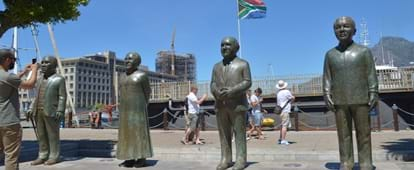By creating an account, I agree to the
Terms of service and Privacy policy
Choose your country and language:
Africa
Americas
Asia Pacific
Europe
WWhat do Albert Luthuli, former president of the African National Congress, Archbishop Emeritus Desmond Tutu, last president of the ‘old South Africa’ FW de Klerk and the legendary Nelson Mandela have in common? They all won the Nobel Peace Prize and their effigies stand together at Cape Town’s V&A Waterfront.
IIn your wanderings around the V&A Waterfront in Cape Town, you might come across four larger-than-life bronzed gentlemen standing pensively in a row.
They are the central characters of Nobel Square, dedicated to South Africa’s four Nobel Peace Prize laureates: Albert Luthuli, Desmond Tutu, FW de Klerk and Nelson Mandela.
These great men all played their part in helping South Africa to democracy after decades of apartheid.
AAlbert Luthuli, president of the African National Congress (ANC) in 1952, was the first African to win the Nobel Peace Prize. He received his award in December 1961 after being allowed briefly out of South Africa to attend the Nobel ceremony in Oslo.
Throughout much of his political life, Luthuli was arrested, charged and banned from public participation.
'What is important is that we can build a homogeneous South Africa on the basis not of colour but of human values,' – reads the inscription under Luthuli's statue.

AArchbishop Emeritus Desmond Tutu, who was awarded the Nobel Peace Prize in 1984, is one of the world’s most beloved leaders. His fame stretches far beyond South Africa’s borders and his words are relevant to the world at large. Known originally for his opposition to the apartheid regime, he later became a symbol of national reconciliation. He still speaks for the oppressed and the poor.
'A person is a person through other people,' reads the Tutu inscription.
FW de Klerk was South Africa’s last president during apartheid. In 1990 he heralded the social and political winds of change in South Africa by releasing Nelson Mandela from prison, unbanning the ANC and its alliance partners, and working with Mandela and others to establish the country’s new Constitution.
'Our new Constitution is a powerful symbol of reconciliation, justice and of the ending of centuries of conflict,' reads the De Klerk inscription.
After 27 years of imprisonment, Nelson Mandela became South Africa’s first democratically elected president. He, with FW de Klerk, was awarded the Nobel Peace Prize in 1993. The following year, following the historic elections of April 27, he took over the reins of government and led the fledgling democracy with pride and grace.
'Never, never and never again shall it be that this beautiful land will experience the oppression of one by another,' reads the inscription under the Mandela statue.
The sculptor finally chosen to create the historic figures was Claudette Schreuders, a Cape Town artist. She was selected by a panel after a final grouping of 10 artists was asked to present their concepts for Nobel Square.

Nobel Square

